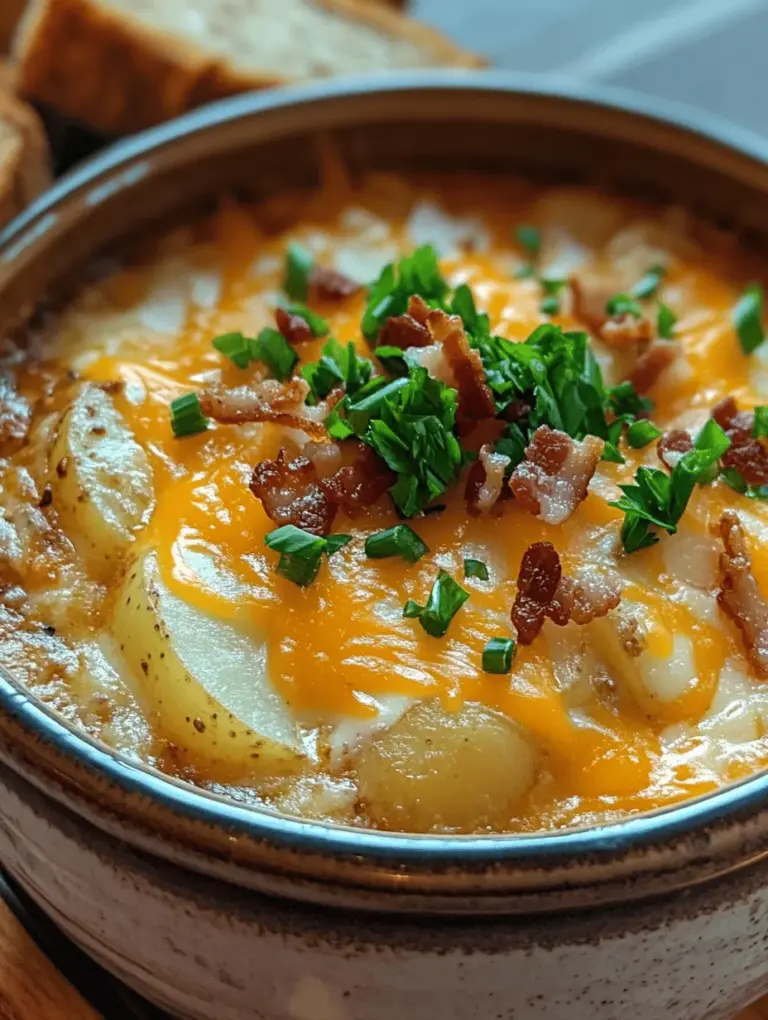Introduction
As the cold months approach, the comforting embrace of a warm soup becomes a cherished part of our daily meals. There’s something incredibly soothing about a steaming bowl of soup, especially when it’s packed with flavors and heartiness. Among the myriad of soup varieties, baked potato soup stands out as a beloved classic. Its creamy texture, coupled with the familiar taste of baked potatoes, makes it a go-to dish for many families.
Baked potato soup not only warms you from the inside out but also brings a sense of nostalgia, reminding us of cozy dinners shared with loved ones. The popularity of this dish can be attributed to its simplicity and the way it captures the essence of home-cooked comfort food. Each spoonful offers a delightful combination of creamy goodness and savory toppings, making it a satisfying meal on its own or a perfect accompaniment to a crisp salad.
What makes this Cozy Baked Potato Soup recipe truly special is its balance of flavors and textures. This recipe elevates the classic baked potato experience by incorporating rich ingredients and easy-to-follow steps. Whether you’re preparing it for a chilly weeknight dinner or a gathering with friends, this soup promises to be a crowd-pleaser. With its creamy base, topped with crispy bacon, sharp cheese, and fresh green onions, this soup is not only delicious but also customizable to suit your tastes.
Understanding the Ingredients
When it comes to crafting the perfect baked potato soup, the choice of ingredients plays a crucial role in achieving a delectable end result. Here’s a closer look at the key components of this comforting dish.
Choosing the Right Potatoes
Selecting the appropriate type of potato is fundamental to the success of your soup. For baked potato soup, russet potatoes are the ideal choice. Known for their starchy content, russets provide a fluffy texture that contributes to the creaminess of the soup. Their sturdy skin also holds up well during baking, adding an extra layer of flavor when incorporated into the dish.
Broth Choices: Chicken vs. Vegetable
The broth you choose can significantly influence the overall flavor profile of your soup. Chicken broth offers a robust and savory base, enhancing the taste of the potatoes and other ingredients. On the other hand, vegetable broth presents a lighter option that works well for those seeking a vegetarian or vegan alternative. Both options provide depth to the soup, so selecting one that aligns with your dietary preferences is essential.
Creaminess with Heavy Cream
To achieve the signature creaminess of baked potato soup, heavy cream is often used. This ingredient adds richness and smoothness, making the soup indulgent and satisfying. However, for those looking for lighter alternatives, options such as half-and-half or even a plant-based cream can be good substitutes. These alternatives still provide a creamy texture without compromising the soup’s overall flavor.
The Flavor Foundation: Onion and Garlic
No soup is complete without the aromatic foundation provided by onions and garlic. These two ingredients are essential in building layers of flavor, as they are sautéed at the beginning of the cooking process. The sweetness of sautéed onions and the pungency of garlic create a savory base that enhances the overall taste of the soup, ensuring that each spoonful is packed with flavor.
Exploring Toppings: Cheese, Bacon, and Green Onions
One of the most exciting aspects of baked potato soup is the array of toppings that can be added to personalize your bowl. Shredded cheese, crispy bacon bits, and freshly sliced green onions not only enhance the flavor but also add interesting textures. The melty cheese provides a creamy finish, while the bacon adds a savory crunch, and the green onions offer a fresh and peppery bite. By experimenting with different toppings, you can tailor the soup to your liking and make it even more appealing.
Step-by-Step Preparation Guide
Now that we’ve covered the essential ingredients, it’s time to dive into the preparation process. This Cozy Baked Potato Soup comes together in a series of straightforward steps that are easy to follow, ensuring a delicious outcome every time.
Baking the Potatoes
The first step in making your baked potato soup is to bake the potatoes to perfection. Begin by preheating your oven to 400°F (200°C). While the oven is heating, take your russet potatoes and scrub them thoroughly under running water to remove any dirt. Once clean, pat them dry with a towel.
To prepare the potatoes for baking, pierce them several times with a fork. This allows steam to escape during the cooking process, preventing the potatoes from bursting in the oven. For added flavor, you can rub the skin with olive oil and sprinkle a generous pinch of salt over them.
Place the prepared potatoes directly on the oven rack and bake for approximately 45 to 60 minutes. The exact cooking time will depend on the size of the potatoes. You’ll know they’re done when the skin is crispy and a fork can easily pierce through the flesh. Once cooked, remove the potatoes from the oven and let them cool slightly before handling.
Sautéing the Base
While the potatoes are baking, you can start preparing the flavorful base for your soup. In a large pot, heat a tablespoon of olive oil or butter over medium heat. Once hot, add finely chopped onions and sauté until they become translucent and fragrant, usually about 5 minutes.
Next, add minced garlic to the pot, stirring constantly to avoid burning. Sautéing the garlic for just 30 seconds to a minute will infuse the oil with its aroma, creating a rich foundation for your soup. The combination of onions and garlic is essential in building a depth of flavor that will elevate your baked potato soup to new heights.
Making the Soup
Once your potatoes are baked and your aromatic base is ready, it’s time to bring everything together. Begin by carefully scooping out the flesh of the baked potatoes, leaving a small amount of potato close to the skin for added texture. Place the potato flesh into a mixing bowl and mash it lightly with a fork or a potato masher.
In the pot with the sautéed onions and garlic, add your choice of broth—chicken or vegetable—and bring it to a gentle simmer. At this point, you can incorporate the mashed potato flesh, stirring to combine. As the soup simmers, the flavors will meld together beautifully, creating a comforting and hearty dish.
Adding Cream and Cheese
To finish off your Cozy Baked Potato Soup, it’s time to add the creamy elements that make this dish so indulgent. Pour in the heavy cream, stirring well to integrate its richness into the soup. If you’re using cheese, now is the perfect time to add shredded cheddar cheese, stirring until it melts and incorporates seamlessly into the mixture.
The cream and cheese will transform your soup into a luxurious bowl of comfort, but remember to taste and adjust the seasoning as necessary. A pinch of salt and pepper can go a long way in enhancing the final flavors of the soup, ensuring it’s perfectly balanced.
With these steps completed, your Cozy Baked Potato Soup is well on its way to becoming a favorite in your household. The combination of baked potatoes, rich cream, and aromatic ingredients creates a dish that is both satisfying and delightful, perfect for those chilly evenings when you crave something warm and fulfilling.
{{image_1}}
Tips for Incorporating Dairy Without Curdling
Incorporating dairy into your Cozy Baked Potato Soup can elevate its creaminess and enhance its flavor. However, curdling can be a concern, particularly when adding dairy to hot soups. Here are some essential tips to prevent that from happening:
1. Temperature Control: Before adding dairy, allow the soup to cool slightly. This reduces the temperature differential and minimizes the risk of curdling.
2. Gradual Addition: Slowly whisk in the dairy (cream, milk, or cheese) rather than dumping it all at once. Gradual incorporation helps stabilize the mixture and prevents curdling.
3. Use Lower Fat Dairy: Higher fat content dairy tends to curdle less. If you’re using low-fat options, consider tempering them by mixing them with a bit of the hot soup before adding them to the pot.
4. Avoid Boiling: Once the dairy has been added, avoid boiling the soup again. Instead, keep it at a gentle simmer to maintain a smooth texture.
Cheese Melting Techniques for a Smooth Finish
Cheese can enhance the richness of your baked potato soup, but it’s essential to melt it properly for a smooth finish. Here are some techniques to achieve that:
1. Shred the Cheese: Always shred or grate cheese before adding it to the soup. This increases the surface area and helps it melt more evenly.
2. Use a Low Heat: Add cheese over low heat to allow it to melt gradually without clumping. Stir frequently to promote even melting.
3. Combine Different Cheeses: Mixing cheeses—like a sharp cheddar for flavor and a cream cheese for creaminess—can create a delightful texture and taste.
Optional Blending
Blending your soup can create a velvety texture that some may prefer. Here are a few considerations regarding blending:
1. Differences in Texture: A blended soup results in a smooth, creamy consistency, while a chunkier version retains the texture of the potatoes and other ingredients.
2. When to Consider Blending: If you enjoy a more refined soup or are serving it to guests, blending may be ideal. You can blend the entire soup or just a portion to maintain some chunkiness while achieving a creamy base.
Serving Suggestions
Serving your Cozy Baked Potato Soup is as important as preparing it. Here are some creative ideas to enhance your presentation and enjoyment:
1. Garnish Creatively: Top your soup with freshly chopped chives, crispy bacon bits, shredded cheese, or a dollop of sour cream. These garnishes add both flavor and visual appeal.
2. Ideal Pairings: Consider serving the soup with crusty bread, buttery crackers, or a fresh garden salad. These accompaniments complement the soup’s comforting nature and provide a well-rounded meal.
Nutritional Information
Understanding the nutritional profile of your Cozy Baked Potato Soup can help you make informed choices:
1. Breakdown of Calories and Nutrients: A typical serving of baked potato soup contains approximately 300-400 calories, depending on the amount of cream and cheese used. It can provide a good source of carbohydrates, fiber, and essential vitamins.
2. Health Benefits of Main Ingredients: Potatoes are rich in potassium and vitamin C, while dairy adds calcium and protein. These nutrients contribute to overall health and well-being.
3. Adjustments for Dietary Restrictions: This recipe can easily be modified to cater to various dietary needs. For a gluten-free version, ensure to use gluten-free broth and seasonings. To make it vegetarian, simply omit any meat garnishes or toppings.
Storage and Leftover Ideas
Knowing how to store and repurpose your Cozy Baked Potato Soup is key to minimizing waste and maximizing enjoyment:
1. Best Practices for Storing: Allow your soup to cool to room temperature before transferring it to an airtight container. Refrigerate for up to 4-5 days or freeze for up to 3 months.
2. How to Reheat Without Losing Flavor: When reheating, do so gently over low heat. Stir frequently to prevent sticking and ensure even heating. If the soup thickens, add a splash of broth or milk to achieve the desired consistency.
3. Creative Ways to Use Leftovers: Leftover soup can be transformed into delicious casseroles, mixed into pasta dishes, or used as a flavorful base for dips. Consider adding it to a cheesy potato casserole for an extra creamy texture.
Culinary Tips for Perfecting Your Soup
To ensure your Cozy Baked Potato Soup is nothing short of fantastic, here are some culinary tips:
1. Common Mistakes to Avoid: One common error is overcooking the potatoes, leading to a mushy texture. Cook them until just tender, as they will continue to soften in the soup.
2. Balancing Flavors: Taste as you go and adjust the seasoning with salt, pepper, and your favorite spices. A splash of vinegar or lemon juice can also brighten the flavors.
3. Customizing with Herbs and Spices: Feel free to experiment with different herbs and spices. Fresh thyme, rosemary, or even a pinch of smoked paprika can add a delightful twist to the classic flavor profile.
Cultural and Historical Context of Potato Soup
Potato soup has a rich history that spans various cultures, making it a beloved comfort food in many regions:
1. Brief History: Potato soup has roots in Europe, particularly Ireland, where it was created as a hearty dish for the working class. Over time, variations have emerged, influenced by local ingredients and customs.
2. Variations Around the World: From the creamy potato leek soup of France to the rustic potato soups of Eastern Europe, each culture has its unique take on this comforting dish. In some regions, you might find it spiced with paprika or garnished with local herbs.
3. Comfort Food Traditions: Potato soup epitomizes comfort food, providing warmth and nourishment during colder months. It is often associated with family gatherings and home-cooked meals, creating lasting memories.
Conclusion
Crafting your Cozy Baked Potato Soup can be a rewarding culinary experience. This comforting dish brings together the simple, wholesome flavors of potatoes and dairy, creating a warm hug in a bowl. As you experiment with the recipe, don’t hesitate to inject your personality into it—try new garnishes, adjust the spices, and even incorporate seasonal ingredients.
In the end, the joy of making and enjoying Cozy Baked Potato Soup lies in its versatility and comforting nature. Whether served on a chilly evening or as a delightful companion to your lunch, this soup is sure to bring warmth and satisfaction. So gather your ingredients, follow the steps, and let your creativity shine as you create a bowl of this timeless comfort food that warms both the body and soul.


